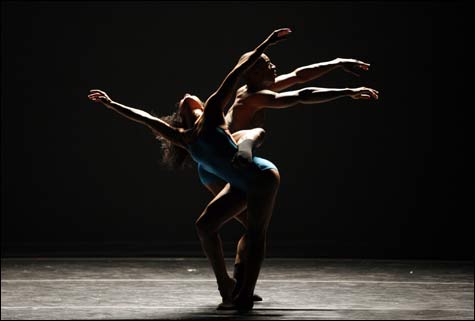
HISSY FITS: Moves and countermoves at torrential speed. |
Half a century ago something known as dance drama occupied a large part of the modern-dance repertory. Great dancers like José Limón and Martha Graham devised choreographic tales of gods and ordinary heroes as vehicles for their companies and their own dancing/acting personalities. Merce Cunningham rejected the emoting and the storytelling, the ego projections, and shifted the focus to pure movement.Now choreographers are revisiting the question of narrative and its crucial dance corollary, expressiveness. Choreographic structure may have fallen away. Particular meanings, characters, and cultural link-ups can be delegated to music, costumes, or visuals. But we’ve realized that even the most objective, pure, and not-so-simple dancing is expressing something.
Complexions Contemporary Ballet seems to have abandoned specifics but intensified the movement’s emotional implications. It’s created a style of virtuosic skill — turning, leaping, high extensions — saturated with the shapes of relentless struggle, desire, attraction, repulsion, and rapture. In last weekend’s Celebrity Series–sponsored performances at the Tsai Performance Center, the hard-hitting, technically terrific dancers took on the job of not only dazzling us but touching our hearts. There was very little choreographic shaping to any of the seven dances, but directors Desmond Richardson and Dwight Rhoden make sure the movement is hyped even higher with Michael Korsch’s theatrical lighting effects and some intriguing musical backgrounds.
Rhoden’s Hissy Fits opened the program. A man and woman, lit from above so as to model their muscular bodies, are pulling apart, wrangling together. We hear loud, aimless piano chords spaced across the silence. Other dancers stride on grimly. Under the lights and some artful smoke, their faces are indistinct. When the chords begin to resolve into a Bach toccata, they hold hands and struggle in a line-up for a moment, then pair up with a partner. One man streaks in and out.
Bach continues, played by a string quartet and piano, with an interlude that might be a Keith Jarrett improvisation. The dance hammers on — couples, duets, solos. The people seem to gravitate to the same partners, but all the partnerships are difficult, and all the moves and countermoves are transacted at torrential speed. A program note informs us that Hissy Fits “captures the uncontrollable emotional impulses that frame our relationships as people.”
Jodie Gates’s Barely Silent, with an atmospheric post-minimalist score by Alan Terriciano, also had an imposing program note about “silent messages” of the body, but it amounted to another dance about couples and their discontents. The two women wore soft pointe shoes, which facilitated various push-against/pull-away/throw-yourself-into-space combinations with their equally aggressive male partners. At times whoever wasn’t dancing receded upstage behind a curtain of light, leaving us to imagine whether the remaining dancer was alone or being surveilled by comrades lurking in the shadows.
To one of Astor Piazzolla’s more elaborate and least rhythmic tangos, an excerpt from The Cyclical Hour (Rhoden) was in essence a string of solos. Only in the last few moment did four of the five dancers pair up with a partner. After these frenetic pieces, the program settled into a more indulgent, but no less power-packed, pop mode.